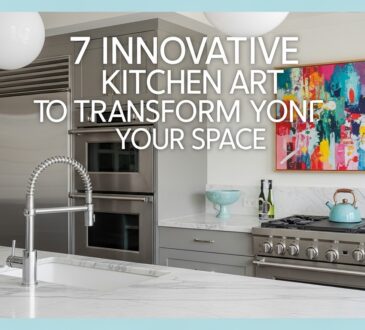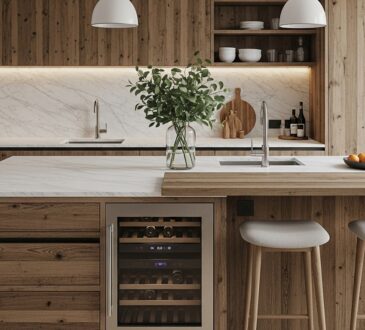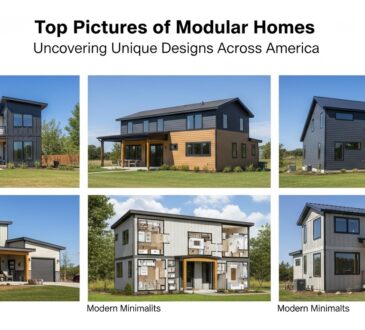7 Creative Energy Efficient Home Designs to Reduce Your Carbon Footprint
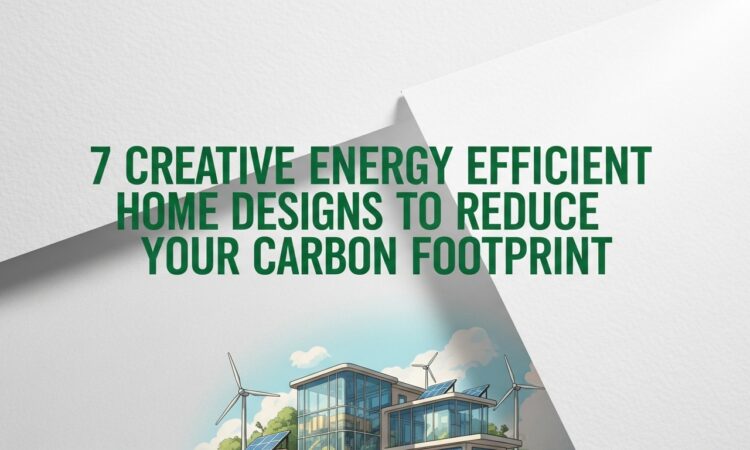
Introduction to Energy Efficient Home Designs
In an era of rising energy costs and growing environmental awareness, the concept of home is undergoing a profound transformation. No longer just a place of shelter, our homes are now at the forefront of the movement towards a sustainable future. The key to this evolution lies in energy efficient home designs—thoughtful, intelligent blueprints that prioritize performance, comfort, and a lighter impact on our planet. An efficient home is not about sacrifice; it’s about smart design that enhances our quality of life while protecting our natural resources.
Benefits of Energy Efficiency
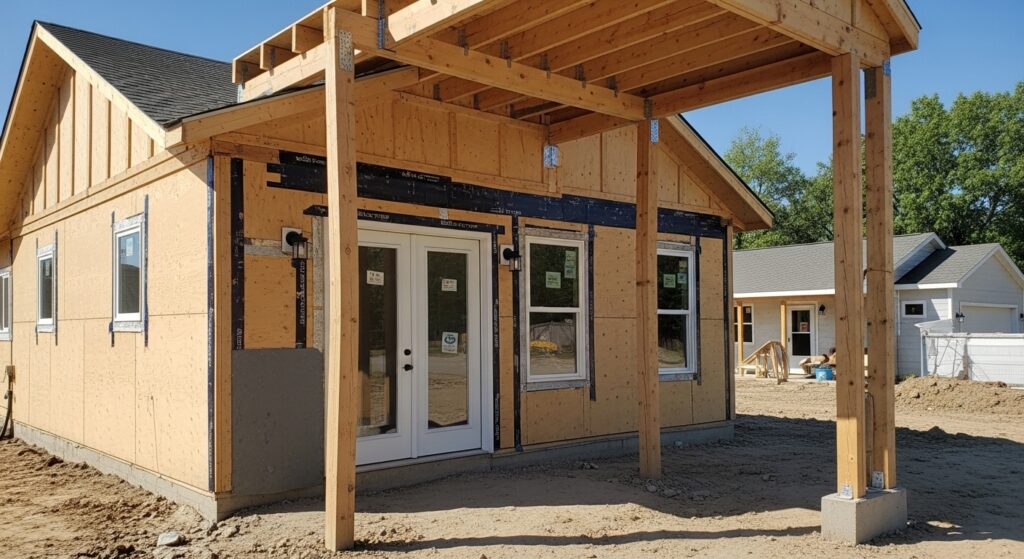
Choosing to build or renovate with energy efficiency in mind offers a wealth of benefits. The most immediate is a significant reduction in monthly utility bills, providing long-term financial stability. But beyond the savings, energy saving homes offer superior comfort, with stable indoor temperatures and no drafts. They also promote a healthier lifestyle through better indoor air quality and the use of non-toxic building materials. Ultimately, an energy efficient household is a more resilient, comfortable, and valuable asset.
Importance of Reducing Carbon Footprint
Every kilowatt of energy saved is a direct contribution to a healthier planet. Residential energy use is a major source of greenhouse gas emissions. By embracing energy efficient home construction, we drastically reduce our home’s energy demand, which in turn cuts down its carbon footprint. Building an energy-efficient home is one of the most impactful personal actions we can take to combat climate change, ensuring a more sustainable world for future generations.
Innovative Features of Energy Efficient Homes
Modern efficient house design leverages a suite of advanced features that work together as a cohesive system. These are the core components that make a home high-performing.
Integrated Renewable Energy Sources
The ultimate goal for many energy efficient new homes is to produce as much energy as they consume (Net-Zero). This is achieved by integrating renewable energy sources directly into the design. Rooftop solar panels are the most common feature, but advanced designs also incorporate geothermal heat pumps that use the earth’s stable temperature to heat and cool the home, as well as solar hot water heaters.
Smart Home Technologies
Technology is a powerful ally in the quest to improve energy efficiency in home. Smart home systems can automate and optimize energy usage with incredible precision. Smart thermostats learn your family’s schedule to avoid unnecessary heating or cooling. Automated lighting and blinds can adjust to the time of day and occupancy, while home energy monitoring systems provide real-time data, empowering homeowners to track their consumption and identify opportunities for further savings.
Efficient Insulation Techniques
The single most critical element of building an energy efficient home is a superior thermal envelope. This starts with high-performance insulation. Modern techniques go beyond standard batts to include spray foam that creates an airtight seal, rigid foam boards that provide a continuous thermal break, and advanced framing techniques that reduce thermal bridging (heat loss through the studs). A well-insulated, airtight home is the foundation of all energy savings.
7 Creative Energy Efficient Home Designs
Thinking about how to make your home energy efficient from the ground up opens up a world of creative possibilities. Here are seven design concepts that blend style with sustainability.
- The Passive Solar Sun Catcher: This design is oriented to work with the sun’s natural path. It features a long southern-facing wall with large, high-performance windows to capture maximum sunlight and heat during the winter. A polished concrete floor acts as a thermal mass, absorbing the heat during the day and slowly releasing it at night. Calculated roof overhangs are designed to block the high summer sun, keeping the home cool without air conditioning.
- The Earth-Sheltered Sanctuary: Using the earth itself as a natural insulator, this design builds the home partially or fully underground. The stable temperature of the surrounding soil drastically reduces the energy needed for heating and cooling. Often featuring a “living roof” of grass and native plants, this design blends seamlessly into the landscape and offers unparalleled protection from the elements.
- The Compact Urban Infusion: Proving that efficiency isn’t just for large rural lots, this design excels in smaller urban spaces. It focuses on multi-functional furniture, vertical space, and clever layouts to make a smaller footprint feel spacious. Features like light-wells, large windows, and reflective interior surfaces maximize natural daylight, reducing the need for artificial lighting in a dense city environment.
- The High-Performance Modern Farmhouse: This concept takes the beloved American farmhouse aesthetic and updates it with 21st-century building science. It maintains the classic gabled rooflines and welcoming porches but incorporates an airtight building envelope, triple-pane windows, and a standing-seam metal roof perfect for solar panel installation, offering timeless style with modern performance.
- The Living Courtyard Home: This design is organized around a central, open-air courtyard. This creates a private outdoor sanctuary while allowing for incredible cross-ventilation and natural light to reach deep into the home’s interior. The courtyard can feature native plants, a water feature for evaporative cooling, and permeable pavers to manage rainwater, creating a mini-ecosystem at the heart of the home.
- The Smart Automated Haven: This is a home designed to “think for itself” to save energy. It integrates a central smart hub that controls lighting, climate, window shades, and appliances. The system can automatically adjust based on occupancy, weather forecasts, and time-of-day electricity rates, ensuring a perfect balance of comfort and efficiency with minimal human effort.
- The Net-Zero Luxury Villa: This design shatters the myth that sustainability requires aesthetic sacrifice. It combines expansive spaces, high-end finishes, and luxurious amenities with top-tier energy performance. Features include geothermal heating, a large solar array with battery backup, a whole-house water recycling system, and floor-to-ceiling triple-pane windows that offer breathtaking views without compromising the building’s thermal envelope.
How to Make Your Home More Energy Efficient
Whether you’re building new or renovating, there are clear strategies for how to make your house more energy efficient.
Tips for Energy Efficient Home Construction
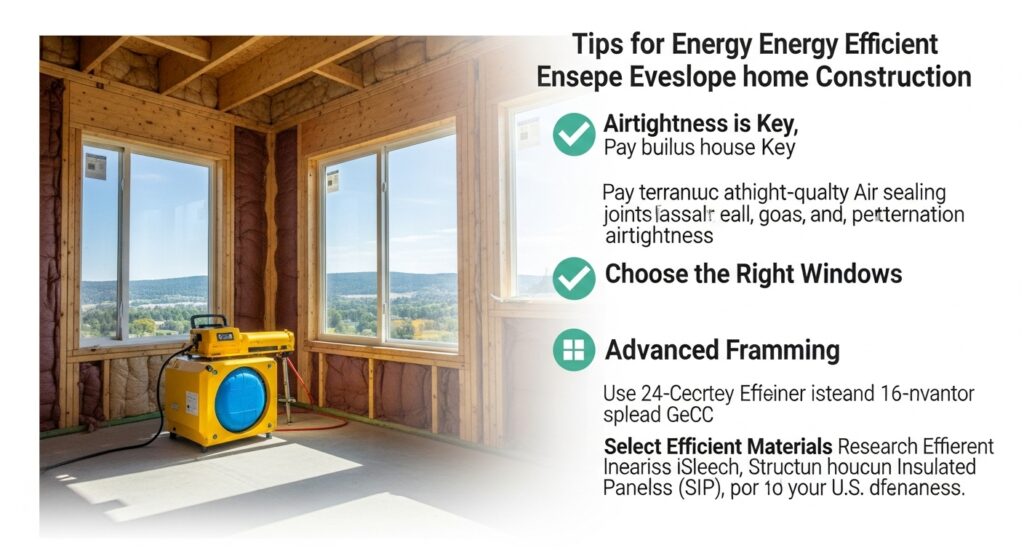
For those building an energy efficient house, the focus should be on the building envelope and systems from day one.
- Airtightness is Key: Pay meticulous attention to air sealing all joints, gaps, and penetrations. A blower door test is essential to measure and improve airtightness.
- Choose the Right Windows: Invest in high-quality, ENERGY STAR certified windows with low U-factors and Solar Heat Gain Coefficients appropriate for your US climate zone.
- Advanced Framing: Use techniques like 24-inch on-center stud spacing instead of 16-inch to reduce the amount of wood (which is a poor insulator) in the walls.
- Select Efficient Materials: Research energy efficient house materials like Insulated Concrete Forms (ICFs), Structural Insulated Panels (SIPs), and reclaimed or sustainably harvested wood.
Affordable Energy Saving Home Improvements
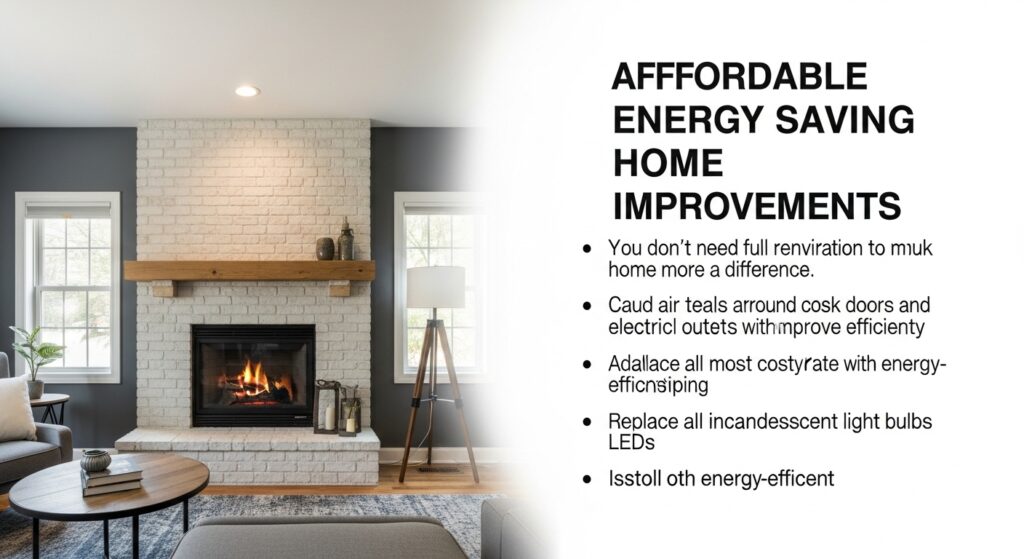
You don’t need a full renovation to make a difference. Here are some cheap ways to make your home more energy efficient:
- Seal air leaks around windows, doors, and electrical outlets with caulk and weatherstripping.
- Add insulation to your attic—it’s often the most cost-effective place to improve efficiency.
- Replace all incandescent light bulbs with energy-efficient LEDs.
- Install a programmable or smart thermostat to automatically adjust temperatures.
Efficient House Design Considerations
Thinking about how to create an energy efficient home involves careful planning. Consider the home’s orientation on the site to control solar gain. Plan window placement to maximize daylight while minimizing overheating. Use deciduous trees on the south side of the home to provide shade in the summer but allow sun in the winter.
Overcoming Challenges in Energy Efficient Home Design
Common Misconceptions
A common myth is that building an energy-efficient home is prohibitively expensive. While some high-performance materials and systems may have a higher upfront cost, they result in significant lifetime savings on energy bills. The return on investment is often realized much faster than people expect. Another misconception is that these homes look strange or futuristic; as the designs above show, energy efficiency can be incorporated into any architectural style.
Financial Incentives and Support
To encourage a move towards energy saving homes, various financial incentives are available. In the United States, the federal government offers significant tax credits for new energy-efficient home construction and for installing renewable energy systems like solar panels. Additionally, many state governments and local utility companies offer their own rebates and support programs. Be sure to research the incentives available in your specific area.
Conclusion: Designing for a Sustainable Future
Final Thoughts on Energy Efficient Home Ideas
The movement toward energy efficient home designs represents one of the most exciting and important shifts in modern residential architecture. It challenges us to think more creatively, build more intelligently, and live more harmoniously with our environment. The ideas and technologies available today make it possible to build homes that are not only beautiful and comfortable but are also powerful tools for positive change.
Encouragement to Embrace Energy Efficient Designs
Choosing to build an energy-efficient home is an investment in your family’s health, your financial future, and the well-being of our planet. It is a forward-thinking choice that provides comfort and security for years to come. We encourage you to explore these designs and embrace the opportunity to create a home that is truly built for a sustainable future.

